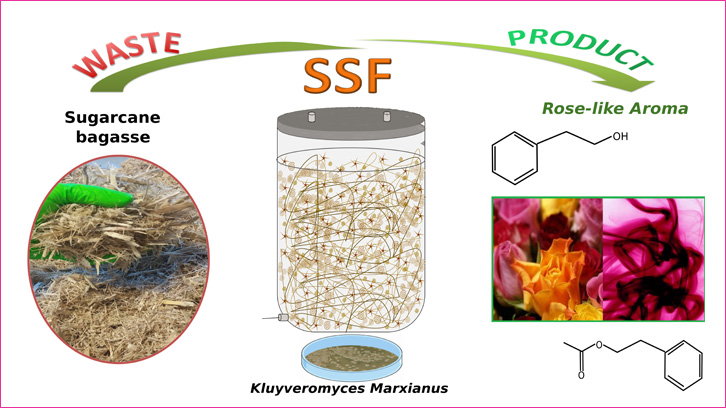Rose-like aromas from agro-industrial residues obtained

Aroma compounds are commonly used in industry to enhance the organoleptic properties of the products, positively influencing the consumer’s perception of them. One of the most used aroma compounds in fragrance, food and chemical sectors is the rose-like scented 2-phenylethanol (2PE). This compound is used in applications such as perfumery, soaps and shampoos production or soft drinks. Also, due to its antifungal and antibacterial properties, it is an appreciated additive in disinfectant, cleaning and personal care products. In general, 2PE is found in nature in plants such as roses, hyacinths or jasmine, but its extraction from these sources is complex and expensive due to its low concentration.
Similarly, the floral-like 2-phenethyl acetate (2PEA) is another aroma compound used alone or in combination with 2PE in decorative cosmetics, fine fragrances, toilet soaps, shampoos, and non-cosmetic products such as household cleaners and detergents. It occurs in nature in plants like evergreen trees and cloves, but its recovery from these sources is also inefficient and costly. Due to the growing demand for these additives, the use of chemical synthesis has been used to obtain these compounds, but the need of acid and basic catalysts and harsh conditions make these paths undesirable since they tend to produce off-odors.
Thus, the search for alternative routes to obtain aroma compounds has become of major interest during the recent years. With this aim, microbial biosynthesis and bioconversion appear as promising substitutes given the ability of some microorganisms to transform some raw materials into valuable aroma compounds.
In the research group GICOM from UAB, we exploit this ability by using the solid-state fermentation technology (SSF), by coupling it with the use of agroindustrial residues as no-cost raw materials, and the development of more efficient and sustainable operation strategies. As an outcome, we obtain environmentally friendly bioprocesses capable of producing value-added products in residue-based systems.
In this study, the 2PE and 2PEA bioproduction via the SSF of sugarcane bagasse (leftover from the sugar industry) was evaluated using the yeast Kluyveromyces marxianus. From this research, it was proven for the first time that a residue-based SSF system could be used to obtain these aroma compounds. Also, the use of segmented feeding (fed-batch) was proposed as a tool to increase the production as well as to enhance the efficiency of the system, reaching promising results in both cases.
The obtained results are evidence of the potential of this technology to become a viable alternative to the 2PE and 2PEA production, following the principle of transformation "from waste to product".
Universitat Autònoma de Barcelona
References
Oscar Martínez, Antoni Sánchez, Xavier Font, Raquel Barrena "Bioproduction of 2-phenylethanol and 2-phenethyl acetate by Kluyveromyces marxianus through the solid-state fermentation of sugarcane bagasse", Applied Microbiology and Biotechnology (2018, 102, 4703-4716).


